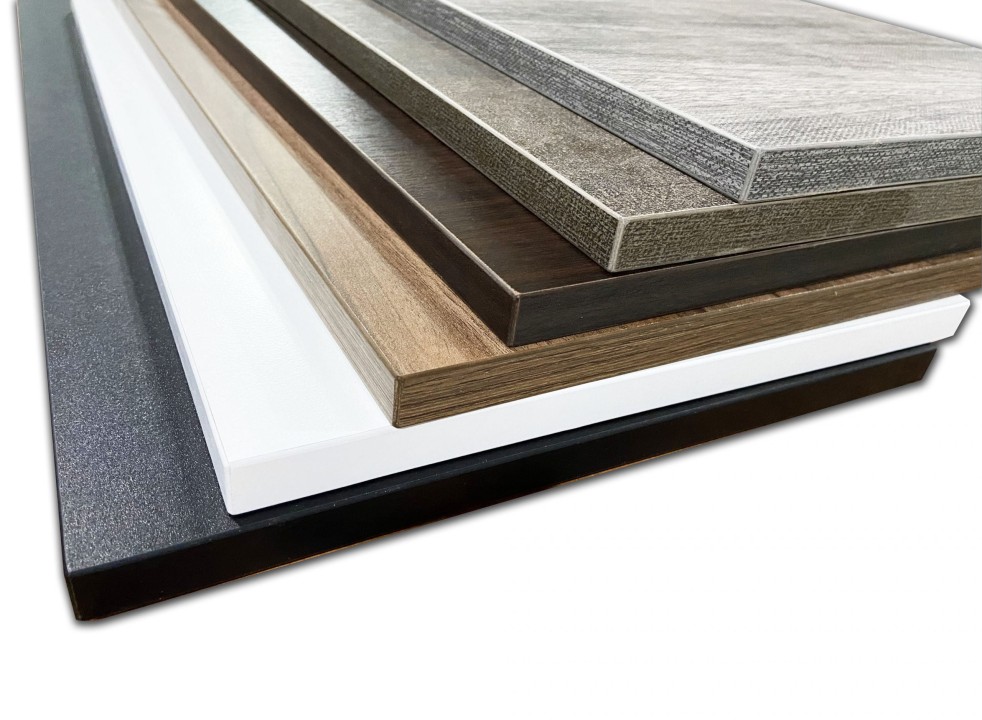
Melamine Boards
First and foremost, what is melamine board?
Melamine board, also known as melamine-faced board or melamine-coated board, is a type of engineered wood product that consists of a particle board or MDF core covered with a melamine laminate. It is commonly used in furniture manufacturing and interior design applications.
Melamine board is created by taking a sheet of particle board or MDF and applying a melamine resin-impregnated paper to its surfaces under high heat and pressure. The melamine resin, which contains melamine formaldehyde, bonds with the board, resulting in a durable and smooth finish.
The melamine laminate on the surface of the board provides several advantages. It offers a protective layer that is resistant to scratches, stains, and moisture. Melamine board is also available in a wide range of colors, patterns, and textures, allowing for diverse design options. The surface can mimic the appearance of wood grain, solid colors, or even textured finishes like matte or glossy.
Melamine board is often used in the construction of furniture, cabinets, shelves, and other interior elements due to its cost-effectiveness, versatility, and durability. It is relatively easy to clean and maintain, making it suitable for various residential and commercial applications.
It's important to note that melamine board should not be confused with solid wood or veneered wood. While it can mimic the look of wood, it is an engineered wood product with a different composition and characteristics.
Overall, melamine board provides an affordable and practical option for achieving a desired aesthetic in furniture and interior design projects, offering a combination of durability, versatility, and design possibilities.
Next question: Is melamine board the same as MDF?
Melamine board is not the same as MDF (Medium-Density Fiberboard). As mentioned earlier, melamine board is a type of engineered wood product where a particle board or MDF core is covered with a melamine laminate on its surfaces.
On the other hand, MDF is a specific type of engineered wood product made by breaking down wood fibers, combining them with resins, and compressing them under high pressure and heat. MDF does not inherently have a melamine laminate on its surface.
Melamine board can be made using either a particle board or MDF core. The choice of core material may impact the overall characteristics and performance of the melamine board. Both particle board and MDF have different densities, strengths, and surface qualities.
Therefore, while melamine board can be made using MDF as the core material, it can also be made with a particle board core. The melamine laminate is applied to the surface of the chosen core material to provide a protective and decorative finish.
In summary, melamine board is a type of engineered wood product that can be made with either particle board or MDF as the core, while MDF is a specific type of engineered wood product that does not inherently have a melamine laminate on its surface.
Final question: How does the melamine board compare to the MDF in terms of furniture making?
Melamine board and MDF (Medium-Density Fiberboard) are distinct materials used in furniture and interior design, each with its own characteristics and benefits. Here's a comparison between the two:
- Core Material: Melamine board can have either a particle board or MDF core. MDF, on the other hand, is a specific type of engineered wood product made solely from wood fibers and resin.
- Surface Finish: Melamine board features a melamine laminate on its surfaces, which provides a smooth, durable, and decorative finish. MDF, by itself, does not have a surface finish and requires additional treatment, such as painting or laminating, to achieve a desired appearance.
- Durability: Both melamine board and MDF are engineered wood products and offer good durability. Melamine board's surface laminate adds resistance to scratches, stains, and moisture, making it more durable in those aspects compared to raw MDF. However, MDF has a denser and more uniform composition, which can contribute to its overall strength and stability.
- Design Options: Melamine board offers a wide range of design options due to its surface laminate. It is available in various colors, patterns, and textures, including wood grain imitations. MDF, on the other hand, can be finished with paints, veneers, or laminates to achieve desired aesthetics. However, the design options may be more limited compared to the wide range available for melamine board.
- Cost: In general, melamine board tends to be more affordable compared to solid wood or MDF with additional finishes. The cost of melamine board can vary depending on factors such as the chosen core material, thickness, and design complexity. MDF is also relatively cost-effective compared to solid wood, but additional treatments or finishes can increase the overall cost.
Ultimately, the choice between melamine board and MDF depends on factors such as budget, desired aesthetics, durability requirements, and specific project considerations. Melamine board offers a ready-to-use finish with diverse design options, while MDF provides a versatile base material that can be customized further.
Administrative Executive at Apcon Pte Ltd
2moThanks Majid Shadmand